MaryAnn Bernal's Blog, page 124
January 21, 2016
'Britain's Pompeii' Found at Bronze Age Settlement
Discovery News
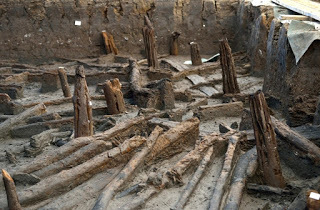 Collapsed roof timbers are seen at the site of a well-preserved Bronze Age dwelling at a quarry in Peterborough.Cambridge Archaeological Unit
Collapsed roof timbers are seen at the site of a well-preserved Bronze Age dwelling at a quarry in Peterborough.Cambridge Archaeological Unit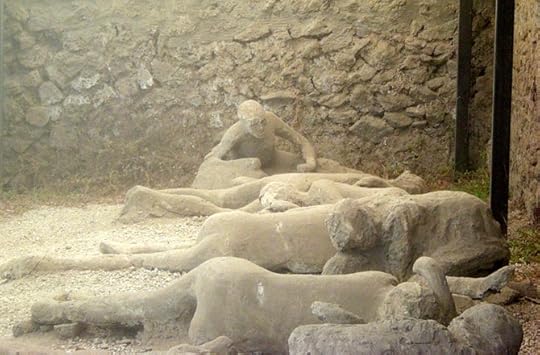
PompeiiVictims'BodiesRevealedinScans:Photos Nearly 2,000 years after Mount Vesuvius buried Pompeii in ash and pumice, advanced imaging technology is bringing to life the victims of the devastating eruption. The CT scanning of the remains has been made possible thanks to a technique devised in 1863 by the archaeologist Giuseppe Fiorelli that produced plaster casts of bodies and objects buried under the ash. Pompeii Pottery Workshop Frozen in TimeLeandro Neumann Ciuffo/Wikimedia Commons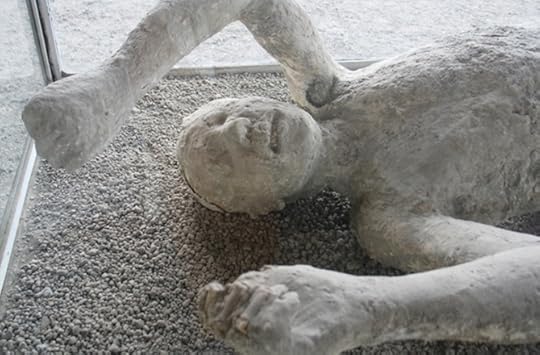
It is believed that about 2,000 people died in Pompeii, yet only 1,150 individuals have been discovered since the mid 19th-century excavations. As Pompeii was buried under 8 to 9 feet of material, bodies were encased in layers of hardened pumice and ash. Fiorelli's team found that their decayed corpses left voids. They poured plaster into the cavities, creating plaster casts of the impression in the ash. Such pictures of horror and death are now being investigated for the first time with a 16-layer CAT technology provided by Philips Spa Healthcare. Pompeii Couple Reunited in Marble InscriptionKamares/Wikimedia Commons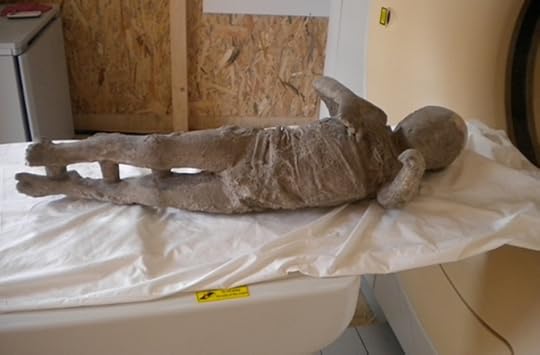
In an unprecedented investigation, a team of researchers under the appointment of the Archaeological Superintendence of Pompeii, Herculaneum and Stabia began CT scanning the 86 plaster casts made by Fiorelli. Among the victims scanned was a boy, about four years old, frozen in terror. "Working with these casts was extremely moving, it felt like I was dealing with real patients," Giovanni Babino, the radiologist in charge of the project said. 'Pompeii:' 10 Strange Facts About the Roman EmpireArchaeological Superintendence of Pompeii, Herculaneum and Stabia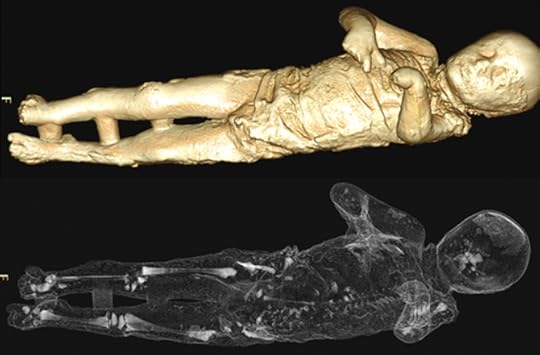 The boy was found next to an adult male and female, likely his parents, and to an infant who appeared to be asleep on his mother's lap. CT scans revealed his clothes and striking details of his skeleton. The investigation also showed that many victims, who were rushing out of their houses in a desperate attempt to escape, were killed by severe head injuries, most likely rubble that fell from collapsing buildings and roofs.Archaeological Superintendence of Pompeii, Herculaneum and Stabia
The boy was found next to an adult male and female, likely his parents, and to an infant who appeared to be asleep on his mother's lap. CT scans revealed his clothes and striking details of his skeleton. The investigation also showed that many victims, who were rushing out of their houses in a desperate attempt to escape, were killed by severe head injuries, most likely rubble that fell from collapsing buildings and roofs.Archaeological Superintendence of Pompeii, Herculaneum and Stabia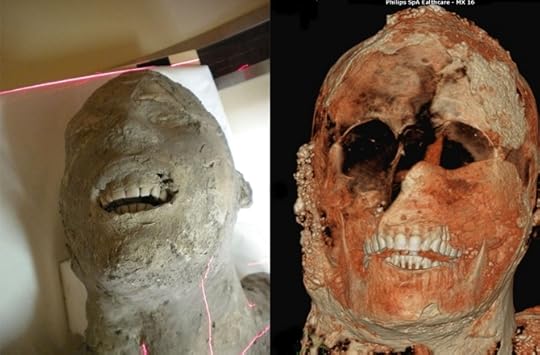
The initial results further suggest that Pompeii's people were rather healthy and blessed with nearly perfect teeth. Few of them suffered from cavities, Elisa Vanacore, a dental expert, said. "They ate a lot of fruit and vegetables but very little sugar," she told reporters. High levels of fluoride in the water that supplied Pompeii also helped.Archaeological Superintendence of Pompeii, Herculaneum and Stabia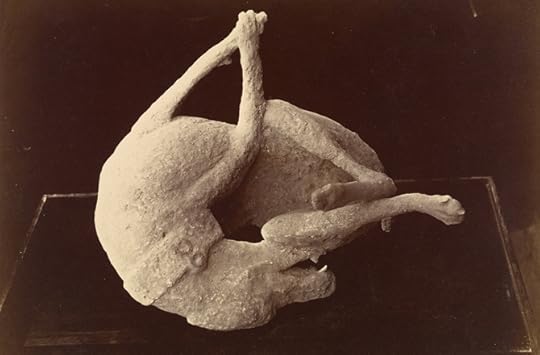
So far, the researchers have scanned 30 casts of men, women, children, a boar and a dog. Convulsed in the last moments of life, the cast of the dog was found to contain no bones. The archaeologists believe the bones were possibly removed from the cavity prior to the Fiorelli casting process. The project is a "great step forward in our knowledge of antiquity," according to the archaeological superintendent of Pompeii Massimo Osanna. "We are going to know a lot about the victims of Pompeii: their age, sex, what they ate, what diseases they had and their social class," he told reporters.Giorgio Sommer/Wikimedia Commons
Britain’s “Pompeii” has emerged in the UK county of Cambridgeshire as archaeologists unearthed incredibly well-preserved Bronze Age dwellings abandoned in haste by their inhabitants.
The excavation, carried out at a quarry in Peterborough by Historic England and the University of Cambridge, provides an extraordinary insight into domestic life 3,000 years ago.
Dating to the end of the Bronze Age (1200-800 BC), the settlement was home to several families who lived in a number of circular wooden houses built on stilts above a river.
Bronze-Age Battle Frozen in Time: Photos
A fire destroyed the settlement causing the houses to fall into the river, where silt and clay preserved the contents.
“It’s a frozen moment in time,” Duncan Wilson, Chief Executive of Historic England, said.
“We are learning more about the food our ancestors ate, and the pottery they used to cook and serve it … This site is of international significance and its excavation really will transform our understanding of the period,” he added.
Photos: Pompeii Victims' Bodies Revealed in Scans
Archaeologists found an extraordinary time capsule buried just over six feet below the ground surface, where the river bed actually was in 1000-800 BC. It contained textiles, small cups, bowls and jars complete with past meals still inside.
Such is the level of preservation that the footprints of those living there are still visible in the waterlogged sediments.
Vases in Pompeii Reveal Panic Before Eruption
The archaeologists also found exotic glass beads that were part of an elaborate necklace, suggesting “a sophistication not usually associated with the British Bronze Age,” Cambridge Archaeological Unit said in a statement.
The way the objects were found indicate people were forced to leave everything behind when fire caught on the houses. It is not known yet whether it was an accident or fire was set deliberately by hostile forces.
The archaeologists expect to find much more as the excavation, which is now half way through the four-year project, continues over the coming months.
Video: Meet the Guy Who Went into a Volcano
“Usually at a Later Bronze Age period site you get pits, post-holes and maybe one or two really exciting metal finds,” David Gibson, archaeological manager at the Cambridge Archaeological Unit, said.
“But this time so much more has been preserved – we can actually see everyday life during the Bronze Age in the round. It’s prehistoric archaeology in 3D with an unsurpassed finds assemblage both in terms of range and quantity,” he added.
 Collapsed roof timbers are seen at the site of a well-preserved Bronze Age dwelling at a quarry in Peterborough.Cambridge Archaeological Unit
Collapsed roof timbers are seen at the site of a well-preserved Bronze Age dwelling at a quarry in Peterborough.Cambridge Archaeological Unit
PompeiiVictims'BodiesRevealedinScans:Photos Nearly 2,000 years after Mount Vesuvius buried Pompeii in ash and pumice, advanced imaging technology is bringing to life the victims of the devastating eruption. The CT scanning of the remains has been made possible thanks to a technique devised in 1863 by the archaeologist Giuseppe Fiorelli that produced plaster casts of bodies and objects buried under the ash. Pompeii Pottery Workshop Frozen in TimeLeandro Neumann Ciuffo/Wikimedia Commons

It is believed that about 2,000 people died in Pompeii, yet only 1,150 individuals have been discovered since the mid 19th-century excavations. As Pompeii was buried under 8 to 9 feet of material, bodies were encased in layers of hardened pumice and ash. Fiorelli's team found that their decayed corpses left voids. They poured plaster into the cavities, creating plaster casts of the impression in the ash. Such pictures of horror and death are now being investigated for the first time with a 16-layer CAT technology provided by Philips Spa Healthcare. Pompeii Couple Reunited in Marble InscriptionKamares/Wikimedia Commons

In an unprecedented investigation, a team of researchers under the appointment of the Archaeological Superintendence of Pompeii, Herculaneum and Stabia began CT scanning the 86 plaster casts made by Fiorelli. Among the victims scanned was a boy, about four years old, frozen in terror. "Working with these casts was extremely moving, it felt like I was dealing with real patients," Giovanni Babino, the radiologist in charge of the project said. 'Pompeii:' 10 Strange Facts About the Roman EmpireArchaeological Superintendence of Pompeii, Herculaneum and Stabia
 The boy was found next to an adult male and female, likely his parents, and to an infant who appeared to be asleep on his mother's lap. CT scans revealed his clothes and striking details of his skeleton. The investigation also showed that many victims, who were rushing out of their houses in a desperate attempt to escape, were killed by severe head injuries, most likely rubble that fell from collapsing buildings and roofs.Archaeological Superintendence of Pompeii, Herculaneum and Stabia
The boy was found next to an adult male and female, likely his parents, and to an infant who appeared to be asleep on his mother's lap. CT scans revealed his clothes and striking details of his skeleton. The investigation also showed that many victims, who were rushing out of their houses in a desperate attempt to escape, were killed by severe head injuries, most likely rubble that fell from collapsing buildings and roofs.Archaeological Superintendence of Pompeii, Herculaneum and Stabia
The initial results further suggest that Pompeii's people were rather healthy and blessed with nearly perfect teeth. Few of them suffered from cavities, Elisa Vanacore, a dental expert, said. "They ate a lot of fruit and vegetables but very little sugar," she told reporters. High levels of fluoride in the water that supplied Pompeii also helped.Archaeological Superintendence of Pompeii, Herculaneum and Stabia

So far, the researchers have scanned 30 casts of men, women, children, a boar and a dog. Convulsed in the last moments of life, the cast of the dog was found to contain no bones. The archaeologists believe the bones were possibly removed from the cavity prior to the Fiorelli casting process. The project is a "great step forward in our knowledge of antiquity," according to the archaeological superintendent of Pompeii Massimo Osanna. "We are going to know a lot about the victims of Pompeii: their age, sex, what they ate, what diseases they had and their social class," he told reporters.Giorgio Sommer/Wikimedia Commons
Britain’s “Pompeii” has emerged in the UK county of Cambridgeshire as archaeologists unearthed incredibly well-preserved Bronze Age dwellings abandoned in haste by their inhabitants.
The excavation, carried out at a quarry in Peterborough by Historic England and the University of Cambridge, provides an extraordinary insight into domestic life 3,000 years ago.
Dating to the end of the Bronze Age (1200-800 BC), the settlement was home to several families who lived in a number of circular wooden houses built on stilts above a river.
Bronze-Age Battle Frozen in Time: Photos
A fire destroyed the settlement causing the houses to fall into the river, where silt and clay preserved the contents.
“It’s a frozen moment in time,” Duncan Wilson, Chief Executive of Historic England, said.
“We are learning more about the food our ancestors ate, and the pottery they used to cook and serve it … This site is of international significance and its excavation really will transform our understanding of the period,” he added.
Photos: Pompeii Victims' Bodies Revealed in Scans
Archaeologists found an extraordinary time capsule buried just over six feet below the ground surface, where the river bed actually was in 1000-800 BC. It contained textiles, small cups, bowls and jars complete with past meals still inside.
Such is the level of preservation that the footprints of those living there are still visible in the waterlogged sediments.
Vases in Pompeii Reveal Panic Before Eruption
The archaeologists also found exotic glass beads that were part of an elaborate necklace, suggesting “a sophistication not usually associated with the British Bronze Age,” Cambridge Archaeological Unit said in a statement.
The way the objects were found indicate people were forced to leave everything behind when fire caught on the houses. It is not known yet whether it was an accident or fire was set deliberately by hostile forces.
The archaeologists expect to find much more as the excavation, which is now half way through the four-year project, continues over the coming months.
Video: Meet the Guy Who Went into a Volcano
“Usually at a Later Bronze Age period site you get pits, post-holes and maybe one or two really exciting metal finds,” David Gibson, archaeological manager at the Cambridge Archaeological Unit, said.
“But this time so much more has been preserved – we can actually see everyday life during the Bronze Age in the round. It’s prehistoric archaeology in 3D with an unsurpassed finds assemblage both in terms of range and quantity,” he added.
Published on January 21, 2016 03:30
History Trivia - Third Crusade initiated
January 21
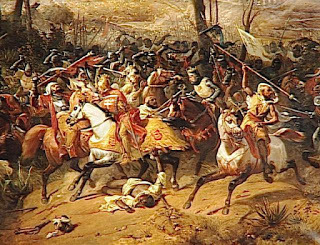
1189 King Philip Augustus of France, King Henry II of England, King Richard I, and Holy Roman Emperor Frederick I Barbarossa initiated the Third Crusade in response to the victory of Saladin in 1187.

1189 King Philip Augustus of France, King Henry II of England, King Richard I, and Holy Roman Emperor Frederick I Barbarossa initiated the Third Crusade in response to the victory of Saladin in 1187.
Published on January 21, 2016 02:30
January 20, 2016
Top 5 Jane Austen recipes
History Extra
 Written by Pen Vogler, the editor of Penguin’s Great Food series, the book also features dishes Jane and her family were known to have enjoyed.
Written by Pen Vogler, the editor of Penguin’s Great Food series, the book also features dishes Jane and her family were known to have enjoyed.
Here, we've selected our top five Jane Austen recipes.
Dinner with Mr Darcy by Pen Vogler is published by CICO Books
Flummery
Flummery is a white jelly, which was set in elegant molds or as shapes in clear jelly. Its delicate, creamy taste goes particularly well with rhubarb, strawberries, and raspberries. A modern version would be to add the puréed fruit to the ingredients, taking away the same volume of water.
1⁄2 cup/50g ground almonds
1 tsp natural rosewater (with no added alcohol)
A drop of natural almond extract
11⁄4 cups/300ml milk
1 1⁄4 cups heavy (double) cream 1–2 tbsp superfine (caster) sugar 5 gelatin leaves
1) Put the gelatin in a bowl and cover with cold water; leave for 4–5 minutes
2) Pour the milk, almonds, and sugar into a saucepan and heat slowly until just below boiling.
3) Squeeze out the excess water from the gelatin leaves and add them to the almond milk. Simmer for a few minutes, keeping it below boiling point. Let it cool a little and strain it through cheesecloth, or a very fine sieve
4) Whip the cream until thick, and then fold it into the tepid mixture. Wet your molds (essential, to make it turn out), put the flummery in (keeping some back for the hen’s nest recipe below if you’d like) and leave to stand in the fridge overnight
5) To serve: If you don’t have a jelly mold with a removable lid, dip the mold briefly into boiling water before turning out the flummery
"To make Flummery Put one ounce of bitter and one of sweet almonds into a basin, pour over them some boiling water to make the skins come off, which is called blanching. Strip off the skins and throw the kernels into cold water. Then take them out and beat them in a marble mortar with a little rosewater to keep them from oiling. When they are beat, put them into a pint of calf’s foot stock, set it over the fire and sweeten it to your taste with loaf sugar. As soon as it boils strain it through a piece of muslin or gauze. When a little cold put it into a pint of thick cream and keep stirring it often till it grows thick and cold. Wet your moulds in cold water and pour in the flummery, let it stand five or six hours at least before you turn them out. If you make the flummery stiff and wet the moulds, it will turn out without putting it into warm water, for water takes off the figures of the mould and makes the flummery look dull." ELIZABETH RAFFALD,THE EXPERIENCED ENGLISH HOUSEKEEPER, 1769
Pigeon Pie
It was the custom to put ‘nicely cleaned’ pigeon feet in the crust to label the contents (although sensible Margaret Dods says ‘we confess we see little use and no beauty in the practice’). Georgian recipes for pigeon pie called for whole birds, but I’ve suggested stewing the birds first, so your guests don’t have to pick out the bones.

Serves 6–8 as part of a picnic spread
4 rashers of streaky bacon, chopped
Slice of lean ham, chopped
4 pigeons with their livers tucked inside (the livers are hard to come by, but worth hunting out)
Flour, seasoned with salt and pepper
9 oz/250 g steak, diced (original cooks would have used rump steak, but you could use something cheaper like topside, diced across the grain of the meat)
Butter
Olive oil
Finely chopped parsley
2 white onions, roughly chopped
A bouquet garni of any of the following, tied together: thyme, parsley, marjoram, winter savory, a bay leaf
Beurre manie made with about 2 tsp butter and 2 tsp flour
1lb/500g rough puff pastry, chilled
Optional additions: 1 onion, peeled and quartered; 2 carrots, roughly chopped; 1 celery stick, roughly chopped
1) Brown the bacon and then the ham in a frying pan, then add the onions, if using, and cook until they are translucent. Transfer the mixture to a large saucepan
2) Flour the pigeons well and brown them all over in butter and olive oil in a frying pan, transferring them to the same large saucepan. Flour and brown the steak in the same way
3) Put the pigeons in a saucepan, and push the steak, bacon, and onions down all around them (choose a saucepan in which they will be quite tightly packed). Although the original recipe doesn’t include them, you may want to add the carrots and celery stick to improve the stock.
Add approximately 11⁄4 cups/300ml water, or enough to just cover the contents. Cover the pan, and simmer slowly until the meat comes off the pigeon bones — at least an hour.
Do not allow the pan to come to a boil or the beef will toughen. Remove from the heat.
4) When it is cool enough to handle, remove the steak and pigeons with a slotted spoon, and carefully pull the pigeon meat off the bones, keeping it as chunky as possible, and put it, with the livers from the cavity, with the steak. You should have a good thick sauce; if it is too thin, stir in the beurre manie a little at a time.
Wait for it to cook the flour, and thicken before adding any more, until you have the right consistency.
5) Preheat the oven to 375°F/190°C/Gas Mark 5. Roll out two-thirds of the pastry and line a pie dish about 3 inches/8cm deep, keeping a good 1⁄4 inch/5mm of pastry above the lip of the dish to allow for shrinkage
6) Prick the bottom of the pastry and bake blind for 12 minutes. Add the meat mixture and pour in enough gravy to come to within an inch of the top.
Roll out the remaining pastry to cover the top, crimping the edges together. Make a vent in the center, and use the trimmings to decorate.
You may like to use the point of the knife to make small slash marks in the shape of pigeon footprints — a nod to the “nicely cleaned feet” of the original recipe. Bake for 25– 30 minutes until the pastry is lightly golden, and cooked through
7) To serve, this is a juicier pie than we are used to for picnics, so you will need plates, and knives and forks, in the Georgian manner
Clean and season the pigeons well in the inside with pepper and salt. Put into each bird a little chopped parsley mixed with the livers parboiled and minced, and some bits of butter. Cover the bottom of the dish with a beef-steak, a few cutlets of veal, or slices of bacon, which is more suitable. Lay in the birds; put the seasoned gizzards, and, if approved, a few hard-boiled yolks of egg into the dish. A thin slice of lean ham laid on the breast of each bird is an improvement to the flavour. Cover the pie with puff paste. A half-hour will bake it.
Observation — It is common to stick two or three feet of pigeons or moorfowl into the centre of the cover of pies as a label to the contents, though we confess we see little use and no beauty in the practice. Forcemeat-balls may be added to enrich the pie. Some cooks lay the steaks above the birds, which is sensible, if not seemly. MARGARET DODS, THE COOK AND HOUSEWIFE’S MANUAL, 1826
Bath Olivers
These savory crackers (biscuits) were devised by William Oliver, an 18th-century physician in Bath after he realised the Bath Buns he had also invented were making his fashionable patients even fatter. They are perfect served with the English cheeses that the Georgian “higher sort” were beginning to enjoy.
Makes 30–40 crackers
Pinch of salt
3 3⁄4 cups/500g all-purpose (plain) flour
2 tablespoons/30g butter
1⁄4 oz/7g sachet active dried yeast
2⁄3 cup/150ml milk
1) Preheat the oven to 325°F/160°C/Gas Mark 3
2) Sift the flour into a bowl and add the dried yeast and salt.Warm the butter and milk together, make a well in the flour and slowly add the liquid, stirring the flour into the center until you have a dough. Add some warm water if necessary
3) Knead the dough on a floured surface until smooth; put it back in the bowl, cover and let it rise in a warm place for 30 minutes
4) Roll out well on a floured surface several times, folding the dough on itself, until it is very thin
5) Cut out with a circular biscuit cutter and prick the surface with a fork
6) Bake for 20–30 minutes until they are hard and bone-colored; if they are turning color, turn the oven down to 300°F/150°C/Gas Mark 2
7) To serve: With a rich local dairy industry, Jane’s circle and characters were likely to have often served local cheeses, including the famous Somerset Cheddar.
Mr Elton gives a clue to what a cheese course might consist of when he unromantically describes his whole dinner of the previous night to Harriet, when Emma overtakes them “and that she was herself come in for the Stilton cheese, the north Wiltshire, the butter, the celery, the beet-root and all the dessert”.
Mrs Norris happily gets both a receipt for and a sample of “a famous cream cheese” from the housekeeper at Sotherton. Mrs Austen describes “good Warwickshire cheese” made in the “delightful dairy” at Stoneleigh Abbey.
To Make Ollivers Biscuits Take 3llb of flour, 1⁄2 a pint of small beer barm. Take some milk and warm it a little put it to your barm and lay a spunge, let it lay for one hour. Then take a quarter of a pound of butter and warm up with some milk and mix your spunge and lay it to rise before the fire. Roll it out in thin cakes, bake it in a slow oven. (You must put a little salt in your flour, but not much, use them before the fire before you put them in the oven).
MARTHA LLOYD’S HOUSEHOLD BOOK
Negus

This mulled wine, created by Colonel Francis Negus (d.1732), was served at the balls in Mansfield Park and The Watsons, and was often offered to guests before their chilly journey home. By Victorian times it was thought to be the thing for children’s birthday parties! This version is safer served to adults.
Serves 16-20
1 x 25 fl oz/75cl bottle of port 25 fl oz/750 ml water
1–2 tbsp brown sugar
Zest and juice of 1 lemon
About 1 tsp freshly grated nutmeg Optional extra spices: 1 cinnamon stick and/or 8 whole cloves
Segments of orange and lemon, to serve
1) Put the water in a saucepan and add the lemon zest, a tablespoon of sugar and the spices. Bring it to a boil and let it simmer very gently for 10–15 minutes. Add the lemon juice
2) Strain, return to the saucepan and reheat. Add the port; taste it, and add a little more sugar if you like. Pour in the port and heat very gently to serving temperature. Put slices of lemon and/or orange into glasses before pouring in the Negus — or serve it from a pitcher (jug)
Miss Debary's Marmalade
Miss Debary was one of the “endless Debarys”; four sisters unloved by Jane who said they were “odious’” (letter to Cassandra 8 September 1816), and had bad breath! (letter to Cassandra, 20 November 1800). Marmalade was made from all kinds of fruit and eaten for dessert until the Scots made it from bitter Seville oranges and started serving it for breakfast at the end of the 18th century.
Makes 6 x 1 lb (450g) jars
1.5kg (3 1⁄4 lb) Seville oranges 2 sweet oranges
1 scant gallon/3.5 litres water
Juice of 2 lemons
About 6 lb/2.75 kg preserving sugar
1) Weigh the fruit and to each 18 oz/500g of fruit weigh out 26 oz/750g sugar. Quarter the fruit and cut off the rind, taking off a little of the pith if you want a sweeter marmalade
2) Boil the rind in water for 11⁄2 –2 hours; there should be a third of the water left. When it is cool, cut the rind into thin slices about 3⁄8 –3⁄4 inch/1–2cm long; Georgian cooks called these “chips”.
Chop the pulp and pick out the seeds (pips) and pith, or push it through a sieve. Put the chips, pulp and lemon juice into the water used to boil the rinds, and bring to a boil.
Add the sugar and boil vigorously for twenty minutes, stirring to make sure it doesn’t catch on the bottom. When you have put the marmalade on to boil, leave a saucer in the fridge and put your jars on baking sheets into the oven at 350°F/180°C/Gas Mark 4 and leave them to sterilize for 20 minutes
3) After 20 minutes, put a little of the marmalade onto the cold plate. If it sets, it is ready; if not, test every five minutes until you get a set
4) Let the marmalade cool a little before decanting it into the hot jars. When it is cold, put wax paper on the surface, before adding the lids
 Written by Pen Vogler, the editor of Penguin’s Great Food series, the book also features dishes Jane and her family were known to have enjoyed.
Written by Pen Vogler, the editor of Penguin’s Great Food series, the book also features dishes Jane and her family were known to have enjoyed.Here, we've selected our top five Jane Austen recipes.
Dinner with Mr Darcy by Pen Vogler is published by CICO Books
Flummery
Flummery is a white jelly, which was set in elegant molds or as shapes in clear jelly. Its delicate, creamy taste goes particularly well with rhubarb, strawberries, and raspberries. A modern version would be to add the puréed fruit to the ingredients, taking away the same volume of water.
1⁄2 cup/50g ground almonds
1 tsp natural rosewater (with no added alcohol)
A drop of natural almond extract
11⁄4 cups/300ml milk
1 1⁄4 cups heavy (double) cream 1–2 tbsp superfine (caster) sugar 5 gelatin leaves
1) Put the gelatin in a bowl and cover with cold water; leave for 4–5 minutes
2) Pour the milk, almonds, and sugar into a saucepan and heat slowly until just below boiling.
3) Squeeze out the excess water from the gelatin leaves and add them to the almond milk. Simmer for a few minutes, keeping it below boiling point. Let it cool a little and strain it through cheesecloth, or a very fine sieve
4) Whip the cream until thick, and then fold it into the tepid mixture. Wet your molds (essential, to make it turn out), put the flummery in (keeping some back for the hen’s nest recipe below if you’d like) and leave to stand in the fridge overnight
5) To serve: If you don’t have a jelly mold with a removable lid, dip the mold briefly into boiling water before turning out the flummery
"To make Flummery Put one ounce of bitter and one of sweet almonds into a basin, pour over them some boiling water to make the skins come off, which is called blanching. Strip off the skins and throw the kernels into cold water. Then take them out and beat them in a marble mortar with a little rosewater to keep them from oiling. When they are beat, put them into a pint of calf’s foot stock, set it over the fire and sweeten it to your taste with loaf sugar. As soon as it boils strain it through a piece of muslin or gauze. When a little cold put it into a pint of thick cream and keep stirring it often till it grows thick and cold. Wet your moulds in cold water and pour in the flummery, let it stand five or six hours at least before you turn them out. If you make the flummery stiff and wet the moulds, it will turn out without putting it into warm water, for water takes off the figures of the mould and makes the flummery look dull." ELIZABETH RAFFALD,THE EXPERIENCED ENGLISH HOUSEKEEPER, 1769
Pigeon Pie
It was the custom to put ‘nicely cleaned’ pigeon feet in the crust to label the contents (although sensible Margaret Dods says ‘we confess we see little use and no beauty in the practice’). Georgian recipes for pigeon pie called for whole birds, but I’ve suggested stewing the birds first, so your guests don’t have to pick out the bones.

Serves 6–8 as part of a picnic spread
4 rashers of streaky bacon, chopped
Slice of lean ham, chopped
4 pigeons with their livers tucked inside (the livers are hard to come by, but worth hunting out)
Flour, seasoned with salt and pepper
9 oz/250 g steak, diced (original cooks would have used rump steak, but you could use something cheaper like topside, diced across the grain of the meat)
Butter
Olive oil
Finely chopped parsley
2 white onions, roughly chopped
A bouquet garni of any of the following, tied together: thyme, parsley, marjoram, winter savory, a bay leaf
Beurre manie made with about 2 tsp butter and 2 tsp flour
1lb/500g rough puff pastry, chilled
Optional additions: 1 onion, peeled and quartered; 2 carrots, roughly chopped; 1 celery stick, roughly chopped
1) Brown the bacon and then the ham in a frying pan, then add the onions, if using, and cook until they are translucent. Transfer the mixture to a large saucepan
2) Flour the pigeons well and brown them all over in butter and olive oil in a frying pan, transferring them to the same large saucepan. Flour and brown the steak in the same way
3) Put the pigeons in a saucepan, and push the steak, bacon, and onions down all around them (choose a saucepan in which they will be quite tightly packed). Although the original recipe doesn’t include them, you may want to add the carrots and celery stick to improve the stock.
Add approximately 11⁄4 cups/300ml water, or enough to just cover the contents. Cover the pan, and simmer slowly until the meat comes off the pigeon bones — at least an hour.
Do not allow the pan to come to a boil or the beef will toughen. Remove from the heat.
4) When it is cool enough to handle, remove the steak and pigeons with a slotted spoon, and carefully pull the pigeon meat off the bones, keeping it as chunky as possible, and put it, with the livers from the cavity, with the steak. You should have a good thick sauce; if it is too thin, stir in the beurre manie a little at a time.
Wait for it to cook the flour, and thicken before adding any more, until you have the right consistency.
5) Preheat the oven to 375°F/190°C/Gas Mark 5. Roll out two-thirds of the pastry and line a pie dish about 3 inches/8cm deep, keeping a good 1⁄4 inch/5mm of pastry above the lip of the dish to allow for shrinkage
6) Prick the bottom of the pastry and bake blind for 12 minutes. Add the meat mixture and pour in enough gravy to come to within an inch of the top.
Roll out the remaining pastry to cover the top, crimping the edges together. Make a vent in the center, and use the trimmings to decorate.
You may like to use the point of the knife to make small slash marks in the shape of pigeon footprints — a nod to the “nicely cleaned feet” of the original recipe. Bake for 25– 30 minutes until the pastry is lightly golden, and cooked through
7) To serve, this is a juicier pie than we are used to for picnics, so you will need plates, and knives and forks, in the Georgian manner
Clean and season the pigeons well in the inside with pepper and salt. Put into each bird a little chopped parsley mixed with the livers parboiled and minced, and some bits of butter. Cover the bottom of the dish with a beef-steak, a few cutlets of veal, or slices of bacon, which is more suitable. Lay in the birds; put the seasoned gizzards, and, if approved, a few hard-boiled yolks of egg into the dish. A thin slice of lean ham laid on the breast of each bird is an improvement to the flavour. Cover the pie with puff paste. A half-hour will bake it.
Observation — It is common to stick two or three feet of pigeons or moorfowl into the centre of the cover of pies as a label to the contents, though we confess we see little use and no beauty in the practice. Forcemeat-balls may be added to enrich the pie. Some cooks lay the steaks above the birds, which is sensible, if not seemly. MARGARET DODS, THE COOK AND HOUSEWIFE’S MANUAL, 1826
Bath Olivers
These savory crackers (biscuits) were devised by William Oliver, an 18th-century physician in Bath after he realised the Bath Buns he had also invented were making his fashionable patients even fatter. They are perfect served with the English cheeses that the Georgian “higher sort” were beginning to enjoy.
Makes 30–40 crackers
Pinch of salt
3 3⁄4 cups/500g all-purpose (plain) flour
2 tablespoons/30g butter
1⁄4 oz/7g sachet active dried yeast
2⁄3 cup/150ml milk
1) Preheat the oven to 325°F/160°C/Gas Mark 3
2) Sift the flour into a bowl and add the dried yeast and salt.Warm the butter and milk together, make a well in the flour and slowly add the liquid, stirring the flour into the center until you have a dough. Add some warm water if necessary
3) Knead the dough on a floured surface until smooth; put it back in the bowl, cover and let it rise in a warm place for 30 minutes
4) Roll out well on a floured surface several times, folding the dough on itself, until it is very thin
5) Cut out with a circular biscuit cutter and prick the surface with a fork
6) Bake for 20–30 minutes until they are hard and bone-colored; if they are turning color, turn the oven down to 300°F/150°C/Gas Mark 2
7) To serve: With a rich local dairy industry, Jane’s circle and characters were likely to have often served local cheeses, including the famous Somerset Cheddar.
Mr Elton gives a clue to what a cheese course might consist of when he unromantically describes his whole dinner of the previous night to Harriet, when Emma overtakes them “and that she was herself come in for the Stilton cheese, the north Wiltshire, the butter, the celery, the beet-root and all the dessert”.
Mrs Norris happily gets both a receipt for and a sample of “a famous cream cheese” from the housekeeper at Sotherton. Mrs Austen describes “good Warwickshire cheese” made in the “delightful dairy” at Stoneleigh Abbey.
To Make Ollivers Biscuits Take 3llb of flour, 1⁄2 a pint of small beer barm. Take some milk and warm it a little put it to your barm and lay a spunge, let it lay for one hour. Then take a quarter of a pound of butter and warm up with some milk and mix your spunge and lay it to rise before the fire. Roll it out in thin cakes, bake it in a slow oven. (You must put a little salt in your flour, but not much, use them before the fire before you put them in the oven).
MARTHA LLOYD’S HOUSEHOLD BOOK
Negus

This mulled wine, created by Colonel Francis Negus (d.1732), was served at the balls in Mansfield Park and The Watsons, and was often offered to guests before their chilly journey home. By Victorian times it was thought to be the thing for children’s birthday parties! This version is safer served to adults.
Serves 16-20
1 x 25 fl oz/75cl bottle of port 25 fl oz/750 ml water
1–2 tbsp brown sugar
Zest and juice of 1 lemon
About 1 tsp freshly grated nutmeg Optional extra spices: 1 cinnamon stick and/or 8 whole cloves
Segments of orange and lemon, to serve
1) Put the water in a saucepan and add the lemon zest, a tablespoon of sugar and the spices. Bring it to a boil and let it simmer very gently for 10–15 minutes. Add the lemon juice
2) Strain, return to the saucepan and reheat. Add the port; taste it, and add a little more sugar if you like. Pour in the port and heat very gently to serving temperature. Put slices of lemon and/or orange into glasses before pouring in the Negus — or serve it from a pitcher (jug)
Miss Debary's Marmalade
Miss Debary was one of the “endless Debarys”; four sisters unloved by Jane who said they were “odious’” (letter to Cassandra 8 September 1816), and had bad breath! (letter to Cassandra, 20 November 1800). Marmalade was made from all kinds of fruit and eaten for dessert until the Scots made it from bitter Seville oranges and started serving it for breakfast at the end of the 18th century.
Makes 6 x 1 lb (450g) jars
1.5kg (3 1⁄4 lb) Seville oranges 2 sweet oranges
1 scant gallon/3.5 litres water
Juice of 2 lemons
About 6 lb/2.75 kg preserving sugar
1) Weigh the fruit and to each 18 oz/500g of fruit weigh out 26 oz/750g sugar. Quarter the fruit and cut off the rind, taking off a little of the pith if you want a sweeter marmalade
2) Boil the rind in water for 11⁄2 –2 hours; there should be a third of the water left. When it is cool, cut the rind into thin slices about 3⁄8 –3⁄4 inch/1–2cm long; Georgian cooks called these “chips”.
Chop the pulp and pick out the seeds (pips) and pith, or push it through a sieve. Put the chips, pulp and lemon juice into the water used to boil the rinds, and bring to a boil.
Add the sugar and boil vigorously for twenty minutes, stirring to make sure it doesn’t catch on the bottom. When you have put the marmalade on to boil, leave a saucer in the fridge and put your jars on baking sheets into the oven at 350°F/180°C/Gas Mark 4 and leave them to sterilize for 20 minutes
3) After 20 minutes, put a little of the marmalade onto the cold plate. If it sets, it is ready; if not, test every five minutes until you get a set
4) Let the marmalade cool a little before decanting it into the hot jars. When it is cold, put wax paper on the surface, before adding the lids
Published on January 20, 2016 03:30
History Trivia - Simon de Montfort holds first English Parliament
January 20

1265 The first English parliament was held by Simon de Montfort in the Palace of Westminster (Houses of Parliament)and was attended by elected Burgesses and knights.

1265 The first English parliament was held by Simon de Montfort in the Palace of Westminster (Houses of Parliament)and was attended by elected Burgesses and knights.
Published on January 20, 2016 02:00
January 19, 2016
Unraveling the Origins of the Roman Sword Discovered Off Oak Island
Ancient Origins
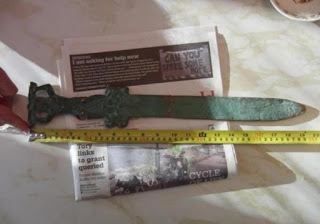 Last month, we reported on the startling discovery of a Roman ceremonial sword off Oak Island , located on the south shore of Nova Scotia, Canada, radically suggesting that ancient mariners visited North America more than a thousand years before Columbus. While the announcement was largely met with surprise and excitement, many have also questioned the authenticity of the artifact. Here we explore the origins of the mysterious Roman sword.
Last month, we reported on the startling discovery of a Roman ceremonial sword off Oak Island , located on the south shore of Nova Scotia, Canada, radically suggesting that ancient mariners visited North America more than a thousand years before Columbus. While the announcement was largely met with surprise and excitement, many have also questioned the authenticity of the artifact. Here we explore the origins of the mysterious Roman sword.
Discovery of the Roman Sword The finding of the Roman sword off Oak Island, which was originally announced by Johnston Press and published in The Boston Standard , was revealed by researchers involved in The History Channel’s series Curse of Oak Island , which details the efforts of two brothers from Michigan as they attempt to solve the mystery of the Oak Island treasure and discover historical artifacts believed to be concealed on the island.
 Main: Oak Island, Nova Scotia. Credit:
Farhad Vladia / Panoramio
. Inset: The Roman sword found in water just off the mysterious Oak Island, Nova Scotia. Credit: investigatinghistory.org and National Treasure Society J. Hutton Pulitzer, lead researcher and historic investigator, along with academics from the Ancient Artifact Preservation Society, have compiled a paper on the finding, which is scheduled to be published in full in early 2016.
Main: Oak Island, Nova Scotia. Credit:
Farhad Vladia / Panoramio
. Inset: The Roman sword found in water just off the mysterious Oak Island, Nova Scotia. Credit: investigatinghistory.org and National Treasure Society J. Hutton Pulitzer, lead researcher and historic investigator, along with academics from the Ancient Artifact Preservation Society, have compiled a paper on the finding, which is scheduled to be published in full in early 2016.
According to Pulitzer, a shipwreck, believed to be Roman, was found off Oak Island, and within the wreck a well-preserved Roman ceremonial sword was retrieved.
Pulitzer told the Boston Standard that the sword was hauled onto a fishing boat decades ago, but was kept secret because the finder and his son feared they would be punished due to strict laws in Nova Scotia regarding retrieving treasures from shipwrecks.
However, relatives of the finder, who is now deceased, recently came forward to reveal the precious sword to researchers.
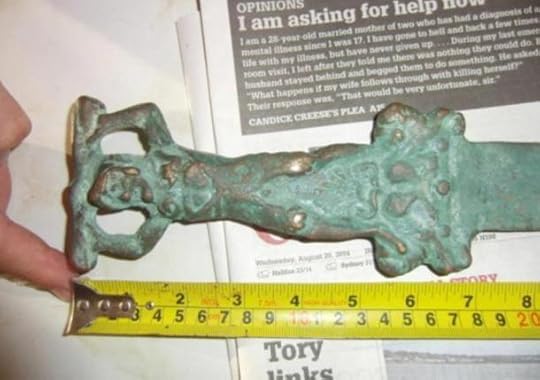 A close-up of the sword found off Oak Island. Photo courtesy of investigatinghistory.org and National Treasure Society Roman Sword discovered off Oak Island radically suggests Ancient Mariners visited New World 1,000 years before Columbus The Lost Treasure of Oak Island and the Centuries-Old Quest to Find It Verifying Authenticity In his blog article ‘ How can a sword cut history? ’, Pultizer states that the sword underwent various analyses, including XRF testing , and has been verified by the Roman Antiquities authority as a gladiator ceremonial votive sword. XRF testing (X-ray fluorescence) is a proven technique for material analysis, including metals. The results found the same arsenic and lead signature in the metal of the sword, down to the atomic level, as that found in other ancient Roman artifacts.
A close-up of the sword found off Oak Island. Photo courtesy of investigatinghistory.org and National Treasure Society Roman Sword discovered off Oak Island radically suggests Ancient Mariners visited New World 1,000 years before Columbus The Lost Treasure of Oak Island and the Centuries-Old Quest to Find It Verifying Authenticity In his blog article ‘ How can a sword cut history? ’, Pultizer states that the sword underwent various analyses, including XRF testing , and has been verified by the Roman Antiquities authority as a gladiator ceremonial votive sword. XRF testing (X-ray fluorescence) is a proven technique for material analysis, including metals. The results found the same arsenic and lead signature in the metal of the sword, down to the atomic level, as that found in other ancient Roman artifacts.
Interestingly, the sword was also found to have magnetic qualities, causing it to point true north, a navigational feature built into some swords of the era through the use of lodestones. Ancient peoples were aware of the magnetic properties of lodestones from as early as the 6 th century BC. Cast iron replicas of Roman swords do not possess such characteristics.
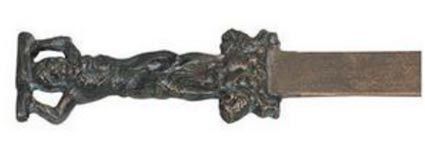 Cast iron replica from the Naples Museum (
Design Toscano
)Symbolism of the Sword Arts and antiquities collector and researcher David Xavier Kenney , has extensively studied the features and symbology of one of the Roman votive swords belonging to the same set, currently owned by a private collector in the Netherlands and dated to between 190 to 192 AD.
Cast iron replica from the Naples Museum (
Design Toscano
)Symbolism of the Sword Arts and antiquities collector and researcher David Xavier Kenney , has extensively studied the features and symbology of one of the Roman votive swords belonging to the same set, currently owned by a private collector in the Netherlands and dated to between 190 to 192 AD.
According to Kenney, the sword hilt depicts a statuette holding a piece of driftwood, tree trunk, branch or club overhead, ready to destroy a shrine that includes a type of Irminsul of the north (pillar that played an important role in Germanic paganism) associated with solar worship.
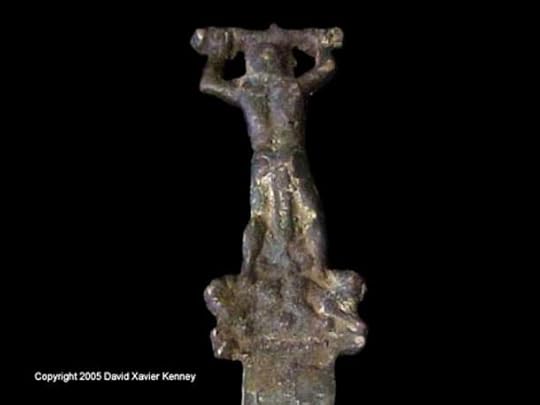 Roman votive sword studied by David Xavier Kenney, dated to 190 to 192 AD. Credit: David Xavier Kenney. Connection with North America Kenney maintains that the symbolism of the sword may reflect an ancient belief that there was a legendary or mythical sacred island to the far north in the west that was associated with a meteor strike, the magnetic, the water compass, navigation, and solar worship.
Roman votive sword studied by David Xavier Kenney, dated to 190 to 192 AD. Credit: David Xavier Kenney. Connection with North America Kenney maintains that the symbolism of the sword may reflect an ancient belief that there was a legendary or mythical sacred island to the far north in the west that was associated with a meteor strike, the magnetic, the water compass, navigation, and solar worship.
By: April Holloway
 Last month, we reported on the startling discovery of a Roman ceremonial sword off Oak Island , located on the south shore of Nova Scotia, Canada, radically suggesting that ancient mariners visited North America more than a thousand years before Columbus. While the announcement was largely met with surprise and excitement, many have also questioned the authenticity of the artifact. Here we explore the origins of the mysterious Roman sword.
Last month, we reported on the startling discovery of a Roman ceremonial sword off Oak Island , located on the south shore of Nova Scotia, Canada, radically suggesting that ancient mariners visited North America more than a thousand years before Columbus. While the announcement was largely met with surprise and excitement, many have also questioned the authenticity of the artifact. Here we explore the origins of the mysterious Roman sword. Discovery of the Roman Sword The finding of the Roman sword off Oak Island, which was originally announced by Johnston Press and published in The Boston Standard , was revealed by researchers involved in The History Channel’s series Curse of Oak Island , which details the efforts of two brothers from Michigan as they attempt to solve the mystery of the Oak Island treasure and discover historical artifacts believed to be concealed on the island.
 Main: Oak Island, Nova Scotia. Credit:
Farhad Vladia / Panoramio
. Inset: The Roman sword found in water just off the mysterious Oak Island, Nova Scotia. Credit: investigatinghistory.org and National Treasure Society J. Hutton Pulitzer, lead researcher and historic investigator, along with academics from the Ancient Artifact Preservation Society, have compiled a paper on the finding, which is scheduled to be published in full in early 2016.
Main: Oak Island, Nova Scotia. Credit:
Farhad Vladia / Panoramio
. Inset: The Roman sword found in water just off the mysterious Oak Island, Nova Scotia. Credit: investigatinghistory.org and National Treasure Society J. Hutton Pulitzer, lead researcher and historic investigator, along with academics from the Ancient Artifact Preservation Society, have compiled a paper on the finding, which is scheduled to be published in full in early 2016. According to Pulitzer, a shipwreck, believed to be Roman, was found off Oak Island, and within the wreck a well-preserved Roman ceremonial sword was retrieved.
Pulitzer told the Boston Standard that the sword was hauled onto a fishing boat decades ago, but was kept secret because the finder and his son feared they would be punished due to strict laws in Nova Scotia regarding retrieving treasures from shipwrecks.
However, relatives of the finder, who is now deceased, recently came forward to reveal the precious sword to researchers.
 A close-up of the sword found off Oak Island. Photo courtesy of investigatinghistory.org and National Treasure Society Roman Sword discovered off Oak Island radically suggests Ancient Mariners visited New World 1,000 years before Columbus The Lost Treasure of Oak Island and the Centuries-Old Quest to Find It Verifying Authenticity In his blog article ‘ How can a sword cut history? ’, Pultizer states that the sword underwent various analyses, including XRF testing , and has been verified by the Roman Antiquities authority as a gladiator ceremonial votive sword. XRF testing (X-ray fluorescence) is a proven technique for material analysis, including metals. The results found the same arsenic and lead signature in the metal of the sword, down to the atomic level, as that found in other ancient Roman artifacts.
A close-up of the sword found off Oak Island. Photo courtesy of investigatinghistory.org and National Treasure Society Roman Sword discovered off Oak Island radically suggests Ancient Mariners visited New World 1,000 years before Columbus The Lost Treasure of Oak Island and the Centuries-Old Quest to Find It Verifying Authenticity In his blog article ‘ How can a sword cut history? ’, Pultizer states that the sword underwent various analyses, including XRF testing , and has been verified by the Roman Antiquities authority as a gladiator ceremonial votive sword. XRF testing (X-ray fluorescence) is a proven technique for material analysis, including metals. The results found the same arsenic and lead signature in the metal of the sword, down to the atomic level, as that found in other ancient Roman artifacts. Interestingly, the sword was also found to have magnetic qualities, causing it to point true north, a navigational feature built into some swords of the era through the use of lodestones. Ancient peoples were aware of the magnetic properties of lodestones from as early as the 6 th century BC. Cast iron replicas of Roman swords do not possess such characteristics.
“History shows many such items were given out by the Emperor to legion commanders, possibly as “protection, strength, and guidance of Hercules” prior to entering into battle or departing on a special mission,” reports Pultizer. “When such ceremonial swords were made they used solid cast, then hand crafted using a lost wax technique, and lastly gilded with gold like various Egyptian artifacts, making them very rare and highly prized.”The Roman sword found off Oak Island is believed to be part of a rare set of votive swords. Four similar swords having been recovered and verified, now in private collections and museums, including the Museum of Naples, Italy, which issued cast iron replicas of the sword. Many replicas of these rare swords can now be found on websites such as eBay and Amazon.
 Cast iron replica from the Naples Museum (
Design Toscano
)Symbolism of the Sword Arts and antiquities collector and researcher David Xavier Kenney , has extensively studied the features and symbology of one of the Roman votive swords belonging to the same set, currently owned by a private collector in the Netherlands and dated to between 190 to 192 AD.
Cast iron replica from the Naples Museum (
Design Toscano
)Symbolism of the Sword Arts and antiquities collector and researcher David Xavier Kenney , has extensively studied the features and symbology of one of the Roman votive swords belonging to the same set, currently owned by a private collector in the Netherlands and dated to between 190 to 192 AD. According to Kenney, the sword hilt depicts a statuette holding a piece of driftwood, tree trunk, branch or club overhead, ready to destroy a shrine that includes a type of Irminsul of the north (pillar that played an important role in Germanic paganism) associated with solar worship.
 Roman votive sword studied by David Xavier Kenney, dated to 190 to 192 AD. Credit: David Xavier Kenney. Connection with North America Kenney maintains that the symbolism of the sword may reflect an ancient belief that there was a legendary or mythical sacred island to the far north in the west that was associated with a meteor strike, the magnetic, the water compass, navigation, and solar worship.
Roman votive sword studied by David Xavier Kenney, dated to 190 to 192 AD. Credit: David Xavier Kenney. Connection with North America Kenney maintains that the symbolism of the sword may reflect an ancient belief that there was a legendary or mythical sacred island to the far north in the west that was associated with a meteor strike, the magnetic, the water compass, navigation, and solar worship. “Most likely much of that belief was based on ancient sea lore about visitations to Iceland and Greenland - that traveled among peoples who did not have a known, or accepted, written language,” writes Kenney.Floating Islands Seen at Sea: Myth and Reality Greed and Decline: The Treasure of the Knights Templar and Their Downfall Evidence to Support Roman Presence in North America In an attempt to dismiss skeptics, who may suggest the artifact had simply fallen off the side of a boat in more recent times, Pultizer and his team have dug up numerous other pieces of evidence to support the theory that the Romans made it to the New World more than 1,000 years before Christopher Columbus. This includes DNA, botanical, linguistic, stone symbols, archaeoastronomy, structure and architectural evidence, artifacts including coins, burial mounds, and a Roman shipwreck — where the Oak Island sword was found.
“Further study in relation to this sword was initially prompted by my findings in 2008 that suggested that some of the sword's symbolism appears to have been connected to the North Atlantic Ocean,” adds Kenney. “I did additional studies in December 2012 on a Roman metal votive artifact found in West Virginia, then a bit more in August of 2014 researching an ancient Native American stone tool/Roman votive artifact from Pennsylvania. Symbolism contained on both of those artifacts appear to indicate at least a Roman knowledge of the Cape York meteorite in Greenland, and possibly with a keen interest.”
“When you put all these things together and you look at the anomalies, it’s not a coincidence,” Pultizer told the Boston Standard. “The plants, the DNA, the artifacts, the language, the ancient drawings - you have something that deserves to be taken seriously.”Featured image: The Roman sword found just off Oak Island. Photo courtesy of investigatinghistory.org and National Treasure Society
By: April Holloway
Published on January 19, 2016 03:30
History Trivia - Battle of Bogesund
January 19
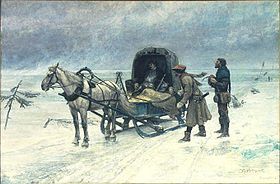
1520 Sten Sture the Younger, the Regent of Sweden, was mortally wounded at the Battle of Bogesund, an important conflict in the campaign of Christian II to gain power over Sweden.

1520 Sten Sture the Younger, the Regent of Sweden, was mortally wounded at the Battle of Bogesund, an important conflict in the campaign of Christian II to gain power over Sweden.
Published on January 19, 2016 02:00
January 18, 2016
Five Missing Kings and Queens – and Where We Might Find Them
Ancient Origins
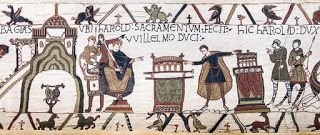
Five Missing Kings and Queens – and Where We Might Find Them As 2016 begins, the recent public interest in hunting for royal burials shows no sign of abating. Hardly has the dust begun to settle on Richard III’s expensive new tomb in Leicester than work is starting on locating the resting place of another medieval monarch, Henry I (d. 1135), in Reading (like Richard III, Henry is also thought to be under a parking lot).
Meanwhile, the Church of England is stoutly refusing to allow DNA tests to be carried out on bones thought to be those of the “ Princes in the Tower ” who disappeared in 1483, and who may be buried in Westminster Abbey.
With the honorable exception of Alfred the Great (d. 899), whose bones were – disappointingly for some – probably not found in recent Winchester excavations, this interest has tended to concentrate on the kings of England after 1066 at the expense of earlier kings, kings of British kingdoms other than England and queens. That is probably typical of the wider public consciousness of – and interest in – the Middle Ages, but it’s not exactly representative of the period. So here are five remarkable royal burials that present puzzles worthy of attention – and that might help add just a little bit of diversity, too.
1. Oswald of Northumbria (d. 642) Oswald was a warlike leader of the northern kingdom of Northumbria, but adopted Christianity with all the zeal of the convert that he was. He so impressed the Irish missionary Aidan by his acts of charity that the latter seized his arm and exclaimed: “May this hand never perish!” Sure enough, it didn’t, remaining uncorrupted after Oswald’s death (or so the story goes).
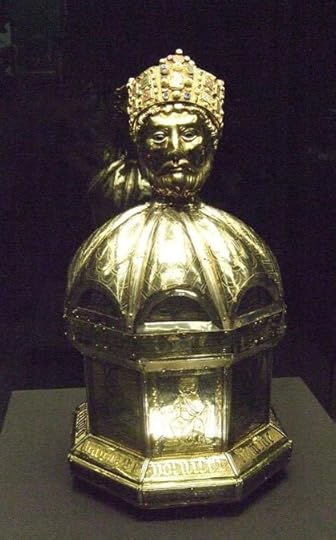 The St Oswald relic. (
Brudersohn/CC BY-SA 3.0
)But it wasn’t just Oswald’s hand that had a remarkable fate. Oswald was killed on the battlefield by pagan Mercians and the Welsh, and his head and limbs put on stakes. Some of these remains were later taken to the monastery of Bardney in Lincolnshire . When this fell under Viking rule in the tenth century, the West Saxon royal family mounted a raid to steal the royal remains and bring them back to English-controlled land. What happened next isn’t entirely clear, but for the modern bone hunter the problem isn’t a lack of evidence – it’s too much of it. In the Middle Ages, five different establishments claimed to own Oswald’s head, from Durham in England through to Hildesheim in Germany, whose magnificent head reliquary survives to this day.
The St Oswald relic. (
Brudersohn/CC BY-SA 3.0
)But it wasn’t just Oswald’s hand that had a remarkable fate. Oswald was killed on the battlefield by pagan Mercians and the Welsh, and his head and limbs put on stakes. Some of these remains were later taken to the monastery of Bardney in Lincolnshire . When this fell under Viking rule in the tenth century, the West Saxon royal family mounted a raid to steal the royal remains and bring them back to English-controlled land. What happened next isn’t entirely clear, but for the modern bone hunter the problem isn’t a lack of evidence – it’s too much of it. In the Middle Ages, five different establishments claimed to own Oswald’s head, from Durham in England through to Hildesheim in Germany, whose magnificent head reliquary survives to this day. 2. Eadgyth (d. 946) Until Oswald’s bones are located, the oldest identified remains of any English – or British – royalty are those of a woman, Eadgyth, daughter of King Edward the Elder . And they’re not even in England. Eadgyth’s brother King Aethelstan sent her and her sister Eadgifu to Germany to allow Duke Otto of Saxony to take his pick of the two for marriage. Otto chose Eadgyth, and when he became emperor, she was anointed as his queen. She remained in Germany until her death in 946.
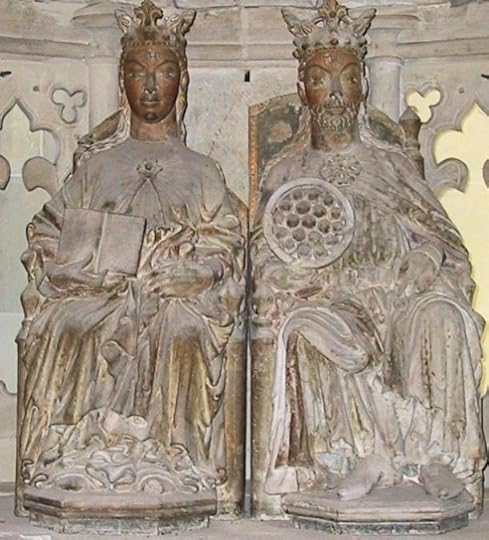 Eadgyth and her husband Otto I, Magdeburg Cathedral. (
Chris 73/CC BY SA 3.0
)Will New Technology Help Relocate the Long Lost Treasure of King John? Searching for the Lost Tomb of Antony and Cleopatra Is Celtic Birdlip Grave the Final Resting Place of Queen Boudicca? In 2008 her tomb in Magdeburg in Germany was opened and, although carbon dating failed, isotopic tests confirmed that the remains were indeed Eadgyth’s. But what’s puzzling is that not all of Eadgyth was actually in the lead casket: her hands and feet were nowhere to be found and most of the skull was missing. What happened to these? Experts at the time of the exhumation suggested that thieves had struck in search of holy relics – but Eadgyth wasn’t generally considered a saint, so the mystery remains.
Eadgyth and her husband Otto I, Magdeburg Cathedral. (
Chris 73/CC BY SA 3.0
)Will New Technology Help Relocate the Long Lost Treasure of King John? Searching for the Lost Tomb of Antony and Cleopatra Is Celtic Birdlip Grave the Final Resting Place of Queen Boudicca? In 2008 her tomb in Magdeburg in Germany was opened and, although carbon dating failed, isotopic tests confirmed that the remains were indeed Eadgyth’s. But what’s puzzling is that not all of Eadgyth was actually in the lead casket: her hands and feet were nowhere to be found and most of the skull was missing. What happened to these? Experts at the time of the exhumation suggested that thieves had struck in search of holy relics – but Eadgyth wasn’t generally considered a saint, so the mystery remains. 3. Harold II (d. 1066)
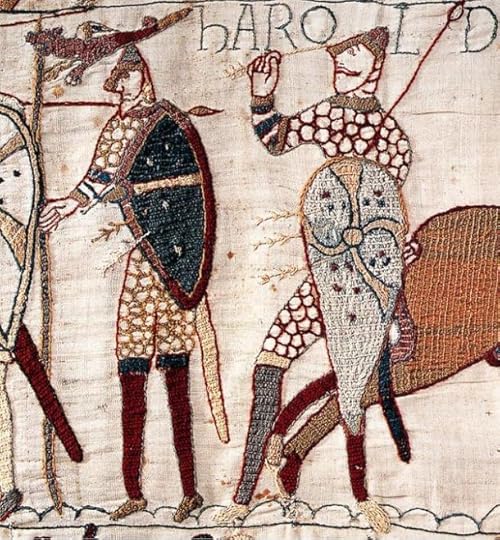 Bayeux tapestry: the death of Harold. (
Lucien Musset's The Bayeux Tapestry/Public Domain
)Everybody knows what happened to King Harold on the battlefield of Hastings in 1066 – but what happened afterwards? Confusion set in early. A contemporary text, The Song of the Battle of Hastings , says that he was buried on a cliff top; a later source claims he survived the battle and lived for many years as a hermit; but other texts – and most historians – suggest he was buried in Waltham Abbey , which he had endowed.
Bayeux tapestry: the death of Harold. (
Lucien Musset's The Bayeux Tapestry/Public Domain
)Everybody knows what happened to King Harold on the battlefield of Hastings in 1066 – but what happened afterwards? Confusion set in early. A contemporary text, The Song of the Battle of Hastings , says that he was buried on a cliff top; a later source claims he survived the battle and lived for many years as a hermit; but other texts – and most historians – suggest he was buried in Waltham Abbey , which he had endowed. Predictably, there is now much talk of finding his tomb. But even if the tomb could be found, could we be sure that it was really Harold inside it? According to the 12th-century Waltham chronicle , Harold’s face was injured beyond recognition by battlefield wounds – and the fallen king was identified for burial only by mysterious “secret marks” on his body known to his concubine, Edith Swanneck. Can we be quite sure that Edith could not have been mistaken? 4. Margaret (d.1093) Margaret was another victim of the Norman conquest, but one whose life took a happier turn than Harold’s. Descended from King Alfred the Great, she was brought up in exile in Hungary before marrying the Scottish king Malcom III . She was treated as a saint soon after her death and her chapel can still be seen in Edinburgh castle . A gospel book she owned also survives in London.
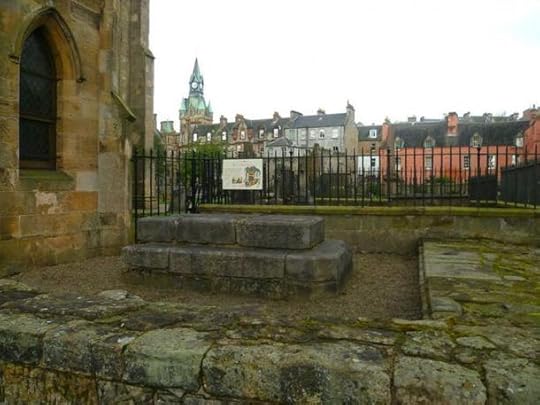 Shrine of St Margaret, Dunfermline Abbey. (
Kim Traynor/CC BY-SA 3.0
)But what remains of Margaret herself is elsewhere. She was buried in Dunfermline Abbey on her death, but later her head was removed and taken to Edinburgh as a relic, and in the confusion of the Reformation it ended up in France - where it was lost in the revolution. Other parts of Margaret’s body were transferred to Spain by Philip II. When Queen Victoria paid for the restoration of Margaret’s tomb in Dumferline, it was probably therefore the restoration of a cenotaph.
Shrine of St Margaret, Dunfermline Abbey. (
Kim Traynor/CC BY-SA 3.0
)But what remains of Margaret herself is elsewhere. She was buried in Dunfermline Abbey on her death, but later her head was removed and taken to Edinburgh as a relic, and in the confusion of the Reformation it ended up in France - where it was lost in the revolution. Other parts of Margaret’s body were transferred to Spain by Philip II. When Queen Victoria paid for the restoration of Margaret’s tomb in Dumferline, it was probably therefore the restoration of a cenotaph. However, in 1862, a Scottish Catholic bishop travelled to Spain to ask for the return of some of Margaret’s remains. He duly secured a relic, which he brought with him back to Edinburgh where it stayed for a century. In 2008, this relic – apparently part of Margaret’s shoulder – was ceremonially handed back to St Margaret’s church in Dunfermline .
The Dramatic Life and Death of Penthesilea: Queen of the Amazons Everything he Touched Turned to Gold: The Myth and Reality of King Midas King Alaric: His Famous Sacking of Rome and Secretive Burial 5. Llwelyn ap Gruffydd (d.1282) Llwelyn was the last leader of an independent Wales and met his fate resisting English imperialism in the shape of Edward I . Hardly had he been killed than his head was cut off and sent to London (though this was less grisly than the treatment meted out to Llwelyn’s former ally, the rebel baron Simon de Montfort, whose testicles were draped over his decapitated head). Llwelyn’s head was stuck on a pike at the Tower of London, where it remained for more than a decade to impress onlookers.
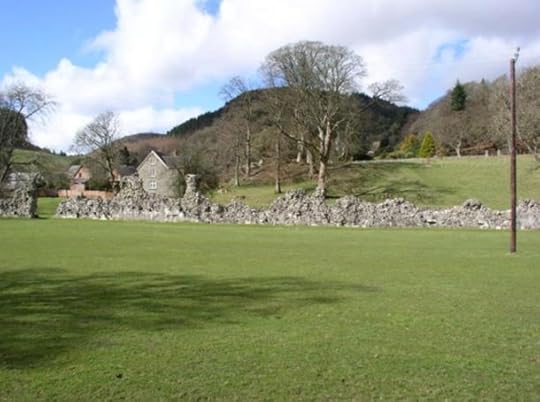 Cwmhir Abbey. (
Eirian Evans/geograph.org.uk/CC BY-SA 2.0
)What happened to the rest of Llwelyn isn’t certain. He was probably buried at Cwmhir Abbey in central Wales. But the archbishop of Canterbury at the time wasn’t entirely sure of this – and even wrote a letter to seek confirmation. The abbey is now in ruins, but no archaeological excavations have taken place to certify the last resting place of (most of) the last independent Welsh ruler.
Cwmhir Abbey. (
Eirian Evans/geograph.org.uk/CC BY-SA 2.0
)What happened to the rest of Llwelyn isn’t certain. He was probably buried at Cwmhir Abbey in central Wales. But the archbishop of Canterbury at the time wasn’t entirely sure of this – and even wrote a letter to seek confirmation. The abbey is now in ruins, but no archaeological excavations have taken place to certify the last resting place of (most of) the last independent Welsh ruler. Featured Image: The Bayeux tapestry: Harold swears his oath to William. Source: Lucas/CC BY 2.0
By: Charles West / The Conversation
The article ' Five missing kings and queens and where we might find them ' by Charles West
was originally published on The Conversation and has been republished under a Creative Commons license.
Published on January 18, 2016 03:30
History Trivia - Third Council of Trent convenes
January 18
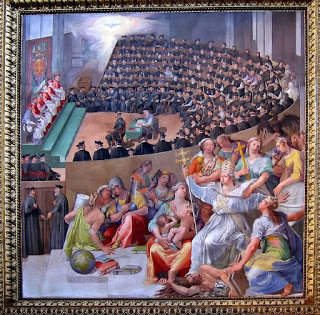
1562 Pope Pius IV reopened the Council of Trent for its third and final session, which defined the mass as a true sacrifice and issued statements on several other doctrinal issues. By the end of the 16th century, many of the abuses that had motivated the Protestant Reformation had disappeared, and the church had reclaimed many of its European followers.

1562 Pope Pius IV reopened the Council of Trent for its third and final session, which defined the mass as a true sacrifice and issued statements on several other doctrinal issues. By the end of the 16th century, many of the abuses that had motivated the Protestant Reformation had disappeared, and the church had reclaimed many of its European followers.
Published on January 18, 2016 02:00
January 17, 2016
Knossos Thrived Well into the Iron Age and Was Much Larger than Once Believed
Ancient Origins
 Current research on the ancient Greek city of Knossos in Crete suggests that it not only recovered from the Bronze Age collapse that brought down many of the Aegean palaces, but actually flourished into the Early Iron Age.
Current research on the ancient Greek city of Knossos in Crete suggests that it not only recovered from the Bronze Age collapse that brought down many of the Aegean palaces, but actually flourished into the Early Iron Age.
The Greek Reporter writes that Knossos was “a cosmopolitan hub of the Aegean and Mediterranean regions” and “rich in imports and was nearly three times larger than what was believed from earlier excavations.”
These were some of the results of fieldwork by Prof. Antonis Kotsonas, of the Univ. of Cincinnati. Kotsonas recently presented his research at the 117th annual meeting of the Archaeological Institute of America and Society for Classical Studies (which was primarily focused on terracotta figurines).
Kotsonas serves as a consultant on the Knossos Urban Landscape Project , and it was his studies with them that brought him to the fields covering ruins of housing and cemeteries in Knossos. The excavation has been thorough and revealed some important details of Iron Age Knossos, including the fact that the site was three times larger than previously believed. According to Kotsonas:
 Artist’s representation of the Palace at Knossos. ( Mmoyaq/ CC BY SA 3.0 )Knossos is reported as Europe’s oldest city and scholars have been studying life in Knossos during the Bronze Age remains for centuries. It is only recently, however, that attention has turned to the city’s development in the Iron Age - around the 11th century BC. It is also a site that is steeped in myth - one of the most famous of which being that of the famed labyrinth created by King Minos to contain the legendary Minotaur.
Artist’s representation of the Palace at Knossos. ( Mmoyaq/ CC BY SA 3.0 )Knossos is reported as Europe’s oldest city and scholars have been studying life in Knossos during the Bronze Age remains for centuries. It is only recently, however, that attention has turned to the city’s development in the Iron Age - around the 11th century BC. It is also a site that is steeped in myth - one of the most famous of which being that of the famed labyrinth created by King Minos to contain the legendary Minotaur.
The Legendary Cretan Labyrinth Cave: Inspiration for the Story of King Minos and the Labyrinth of the Minotaur? King Minos of Crete Ten Mysterious Undeciphered Codes and Inscriptions Origins of the Mysterious Minoans Unraveled by Scientists The researchers studying Knossos have found that the real site is as exciting as the stories of legend. Many new artifacts - bronze and other metals, jewelry, pottery, ornaments, and all sorts of status symbols have been unearthed. Most of these materials were recovered from burial sites. These artifacts have provided evidence for the researchers’ belief that Knossos was a wealthy community during this period.
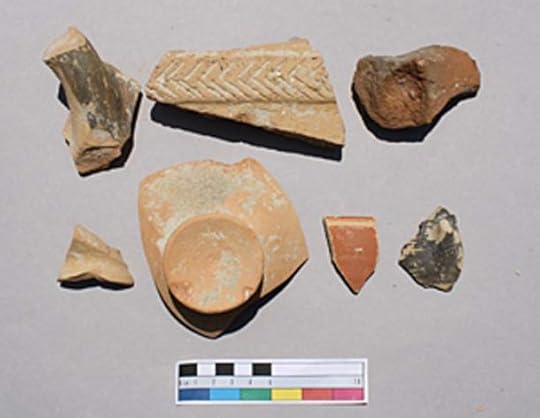 “Larger concentrations of better preserved material from the fringes of early Iron Age Knossos typically suggest a fairly recently disturbed burial context.” (
Todd Whitelaw
)The last decade of the Knossos Urban Landscape Project has really enhanced researchers’ collection of Iron Age artifacts. They have excavated a large section of the settlement from that period and found that with time there was an increase in the quantity and quality of its imports originating from mainland Greece, Cyprus, the Near East, Egypt, Italy, Sardinia, and the western Mediterranean. "No other site in the Aegean period has such a range of imports," Kotsonas stated in a press release .
“Larger concentrations of better preserved material from the fringes of early Iron Age Knossos typically suggest a fairly recently disturbed burial context.” (
Todd Whitelaw
)The last decade of the Knossos Urban Landscape Project has really enhanced researchers’ collection of Iron Age artifacts. They have excavated a large section of the settlement from that period and found that with time there was an increase in the quantity and quality of its imports originating from mainland Greece, Cyprus, the Near East, Egypt, Italy, Sardinia, and the western Mediterranean. "No other site in the Aegean period has such a range of imports," Kotsonas stated in a press release .
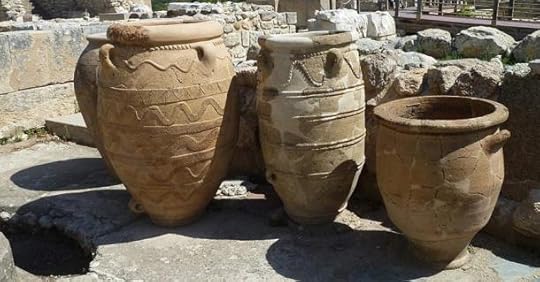 Pithoi (large storage containers) at Knossos, Crete. (
CC BY SA 3.0
)More news will certainly arrive in the future as the Knossos Urban Landscape Project aims to document and analyze the development of the site from 7000 BC to the 20th century. Kotsonas adds that the popularity of the site could also work against archaeologists in the future. He has said that although the “Knossos Urban Landscape Project works to inform the community about the importance of preserving the area that has history yet to be uncovered, history that could be lost if future development destroyed unexplored parts of the site.”
Pithoi (large storage containers) at Knossos, Crete. (
CC BY SA 3.0
)More news will certainly arrive in the future as the Knossos Urban Landscape Project aims to document and analyze the development of the site from 7000 BC to the 20th century. Kotsonas adds that the popularity of the site could also work against archaeologists in the future. He has said that although the “Knossos Urban Landscape Project works to inform the community about the importance of preserving the area that has history yet to be uncovered, history that could be lost if future development destroyed unexplored parts of the site.”
Featured Image: Artist’s rendering of the palace of Knossos. Source: Ancient Images/CC BY NC SA 2.0
By Alicia McDermott
 Current research on the ancient Greek city of Knossos in Crete suggests that it not only recovered from the Bronze Age collapse that brought down many of the Aegean palaces, but actually flourished into the Early Iron Age.
Current research on the ancient Greek city of Knossos in Crete suggests that it not only recovered from the Bronze Age collapse that brought down many of the Aegean palaces, but actually flourished into the Early Iron Age. The Greek Reporter writes that Knossos was “a cosmopolitan hub of the Aegean and Mediterranean regions” and “rich in imports and was nearly three times larger than what was believed from earlier excavations.”
These were some of the results of fieldwork by Prof. Antonis Kotsonas, of the Univ. of Cincinnati. Kotsonas recently presented his research at the 117th annual meeting of the Archaeological Institute of America and Society for Classical Studies (which was primarily focused on terracotta figurines).
Kotsonas serves as a consultant on the Knossos Urban Landscape Project , and it was his studies with them that brought him to the fields covering ruins of housing and cemeteries in Knossos. The excavation has been thorough and revealed some important details of Iron Age Knossos, including the fact that the site was three times larger than previously believed. According to Kotsonas:
Distinguishing between domestic and burial contexts is essential for determining the size of the settlement and understanding the demographic, socio-political and economic development of the local community. Even at this early stage in detailed analysis, it appears that this was a nucleated, rather densely occupied settlement.
 Artist’s representation of the Palace at Knossos. ( Mmoyaq/ CC BY SA 3.0 )Knossos is reported as Europe’s oldest city and scholars have been studying life in Knossos during the Bronze Age remains for centuries. It is only recently, however, that attention has turned to the city’s development in the Iron Age - around the 11th century BC. It is also a site that is steeped in myth - one of the most famous of which being that of the famed labyrinth created by King Minos to contain the legendary Minotaur.
Artist’s representation of the Palace at Knossos. ( Mmoyaq/ CC BY SA 3.0 )Knossos is reported as Europe’s oldest city and scholars have been studying life in Knossos during the Bronze Age remains for centuries. It is only recently, however, that attention has turned to the city’s development in the Iron Age - around the 11th century BC. It is also a site that is steeped in myth - one of the most famous of which being that of the famed labyrinth created by King Minos to contain the legendary Minotaur. The Legendary Cretan Labyrinth Cave: Inspiration for the Story of King Minos and the Labyrinth of the Minotaur? King Minos of Crete Ten Mysterious Undeciphered Codes and Inscriptions Origins of the Mysterious Minoans Unraveled by Scientists The researchers studying Knossos have found that the real site is as exciting as the stories of legend. Many new artifacts - bronze and other metals, jewelry, pottery, ornaments, and all sorts of status symbols have been unearthed. Most of these materials were recovered from burial sites. These artifacts have provided evidence for the researchers’ belief that Knossos was a wealthy community during this period.
 “Larger concentrations of better preserved material from the fringes of early Iron Age Knossos typically suggest a fairly recently disturbed burial context.” (
Todd Whitelaw
)The last decade of the Knossos Urban Landscape Project has really enhanced researchers’ collection of Iron Age artifacts. They have excavated a large section of the settlement from that period and found that with time there was an increase in the quantity and quality of its imports originating from mainland Greece, Cyprus, the Near East, Egypt, Italy, Sardinia, and the western Mediterranean. "No other site in the Aegean period has such a range of imports," Kotsonas stated in a press release .
“Larger concentrations of better preserved material from the fringes of early Iron Age Knossos typically suggest a fairly recently disturbed burial context.” (
Todd Whitelaw
)The last decade of the Knossos Urban Landscape Project has really enhanced researchers’ collection of Iron Age artifacts. They have excavated a large section of the settlement from that period and found that with time there was an increase in the quantity and quality of its imports originating from mainland Greece, Cyprus, the Near East, Egypt, Italy, Sardinia, and the western Mediterranean. "No other site in the Aegean period has such a range of imports," Kotsonas stated in a press release . Pithoi (large storage containers) at Knossos, Crete. (
CC BY SA 3.0
)More news will certainly arrive in the future as the Knossos Urban Landscape Project aims to document and analyze the development of the site from 7000 BC to the 20th century. Kotsonas adds that the popularity of the site could also work against archaeologists in the future. He has said that although the “Knossos Urban Landscape Project works to inform the community about the importance of preserving the area that has history yet to be uncovered, history that could be lost if future development destroyed unexplored parts of the site.”
Pithoi (large storage containers) at Knossos, Crete. (
CC BY SA 3.0
)More news will certainly arrive in the future as the Knossos Urban Landscape Project aims to document and analyze the development of the site from 7000 BC to the 20th century. Kotsonas adds that the popularity of the site could also work against archaeologists in the future. He has said that although the “Knossos Urban Landscape Project works to inform the community about the importance of preserving the area that has history yet to be uncovered, history that could be lost if future development destroyed unexplored parts of the site.” Featured Image: Artist’s rendering of the palace of Knossos. Source: Ancient Images/CC BY NC SA 2.0
By Alicia McDermott
Published on January 17, 2016 03:30
History Trivia - Roman Emperor Otho commits suicide
January 17
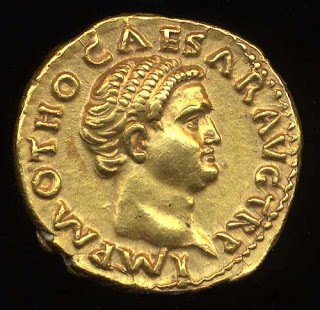
69 Etruscan Roman Emperor Otho committed suicide after a night of meditation in his tent. A companion of Nero, it is believed that he died to prevent civil war.

69 Etruscan Roman Emperor Otho committed suicide after a night of meditation in his tent. A companion of Nero, it is believed that he died to prevent civil war.
Published on January 17, 2016 01:00



